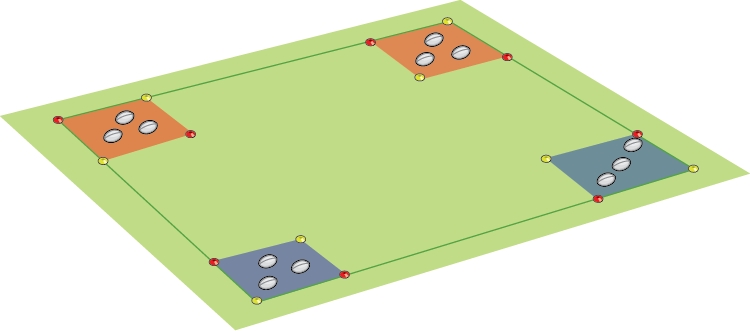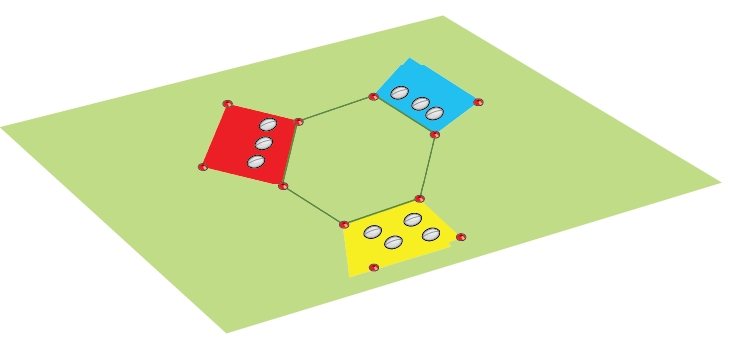You are viewing
1 of your 2 free articles
Dens
Small-Sided Gamesby Tom Brocklebank
This is an adaptation of a game I use in school. It’s great as a warm-up or as a game to encourage and support creativity before moving towards a more rugby-specific game. It encourages and challenges evasion skills, spatial awareness, communication, as well as passing, kicking and catching.

To start with, have a normal rectangular playing area with four 5m corners marked out. You could start with the balls in the middle. However, you can run the risk of collisions, so it may be best to start with equal amounts in each coned area/corner/den.
It doesn’t matter how many balls there are, you may need to add more or take some away depending on how the game plays out.

You can extend this to having a three or four-way pitch but each team needs a coned area (I call them dens when using it in PE) for other teams to put their balls.
ORGANISATION

To start with, have a normal rectangular playing area with four 5m corners marked out. You could start with the balls in the middle. However, you can run the risk of collisions, so it may be best to start with equal amounts in each coned area/corner/den.
It doesn’t matter how many balls there are, you may need to add more or take some away depending on how the game plays out.

You can extend this to having a three or four-way pitch but each team needs a coned area (I call them dens when using it in PE) for other teams to put their balls.
RULES
- The team with the most balls in their corners/dens loses, the aim is to “score” by putting balls into the opposition dens.
- Balls can be passed or kicked in any direction, there are no offsides.
- Start with touch or tag, no contact, look to introduce contact when appropriate.
- If a player is tackled you can either make them leave the ball where they were tackled and retreat back to one of their dens before rejoining, or let them take the ball back with them to one of their dens before rejoining.
- If a ball leaves the area, just let a player go out to get it and bring it back in, no tackling or contact outside the area. If two players try to go then the coach takes the ball and recirculates it into the game.
- If a player leaves the area, they need to return to one of their dens before returning to the game.
POSSIBLE PROGRESSIVE GAME
- No passing or kicking. Players aim to put a ball in the opposition dens. Every player has a bib tucked in their shorts or use tag rugby tags if you have them. If a bib or tag is taken the player drops the ball and must go back to one of their corners before rejoining the game. This game focuses on 1v1 skills of evasion and defensive tracking and position. You can extend to allowing contact tackles.
- Allow passing, no offsides. You can continue with touch or tag tackling or allow contact. Focus on passing skills, taking advantage of 2v1 opportunities, draw and pass, different types of pass, allow offloads to encourage support.
- Allow kicking, no offsides. Players now have the option to kick, so they can kick to teammates in opposition dens. This is a good opportunity to support high ball catching and competing.
- You can add a halfway line and introduce a rule that you can only be tackled in the opposition half. This can encourage teams to have defenders and attackers, and to create a game plan.
Newsletter Sign Up
Coaches Testimonials

Gerald Kearney, Downtown Las Vegas Soccer Club

Paul Butler, Florida, USA

Rick Shields, Springboro, USA

Tony Green, Pierrefonds Titans, Quebec, Canada
Subscribe Today
Be a more effective, more successful rugby coach
In a recent survey 89% of subscribers said Rugby Coach Weekly makes them more confident, 91% said Rugby Coach Weekly makes them a more effective coach and 93% said Rugby Coach Weekly makes them more inspired.
Get Weekly Inspiration
All the latest techniques and approaches
Rugby Coach Weekly offers proven and easy to use rugby drills, coaching sessions, practice plans, small-sided games, warm-ups, training tips and advice.
We've been at the cutting edge of rugby coaching since we launched in 2005, creating resources for the grassroots youth coach, following best practice from around the world and insights from the professional game.
More from us
© 2023 Rugby Coach Weekly
Part of Green Star Media Ltd. Company number: 3008779
We use cookies so we can provide you with the best online experience. By continuing to browse this site you are agreeing to our use of cookies. Click on the banner to find out more.












